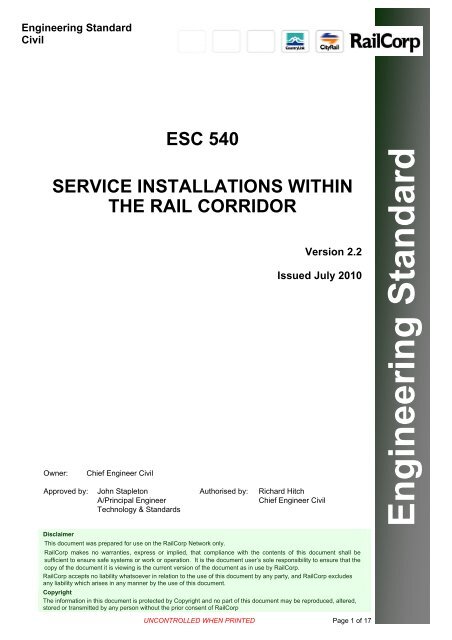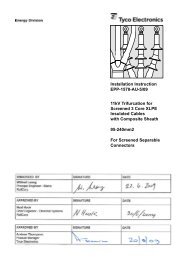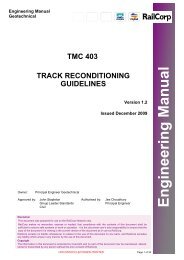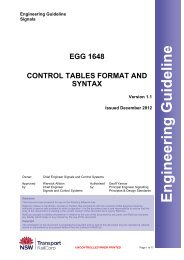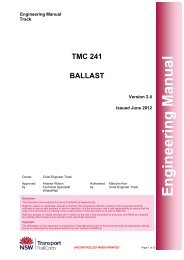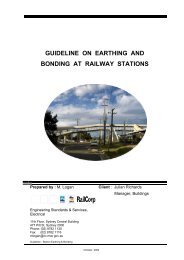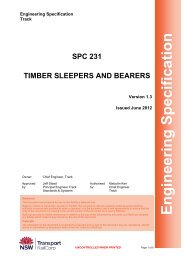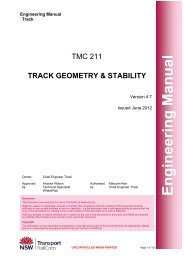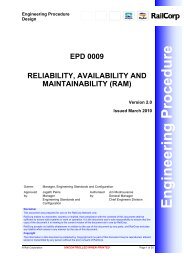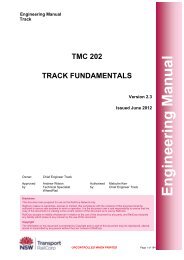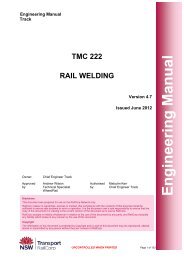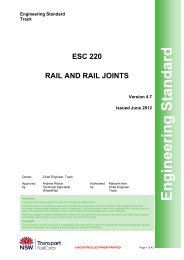ESC 540 - Service Installations within the Rail Corridor - RailCorp ...
ESC 540 - Service Installations within the Rail Corridor - RailCorp ...
ESC 540 - Service Installations within the Rail Corridor - RailCorp ...
You also want an ePaper? Increase the reach of your titles
YUMPU automatically turns print PDFs into web optimized ePapers that Google loves.
Engineering Standard<br />
Civil<br />
Owner: Chief Engineer Civil<br />
Approved by: John Stapleton<br />
A/Principal Engineer<br />
Technology & Standards<br />
<strong>ESC</strong> <strong>540</strong><br />
SERVICE INSTALLATIONS WITHIN<br />
THE RAIL CORRIDOR<br />
Authorised by: Richard Hitch<br />
Chief Engineer Civil<br />
Disclaimer<br />
This document was prepared for use on <strong>the</strong> <strong>Rail</strong>Corp Network only.<br />
<strong>Rail</strong>Corp makes no warranties, express or implied, that compliance with <strong>the</strong> contents of this document shall be<br />
sufficient to ensure safe systems or work or operation. It is <strong>the</strong> document user’s sole responsibility to ensure that <strong>the</strong><br />
copy of <strong>the</strong> document it is viewing is <strong>the</strong> current version of <strong>the</strong> document as in use by <strong>Rail</strong>Corp.<br />
<strong>Rail</strong>Corp accepts no liability whatsoever in relation to <strong>the</strong> use of this document by any party, and <strong>Rail</strong>Corp excludes<br />
any liability which arises in any manner by <strong>the</strong> use of this document.<br />
Copyright<br />
The information in this document is protected by Copyright and no part of this document may be reproduced, altered,<br />
stored or transmitted by any person without <strong>the</strong> prior consent of <strong>Rail</strong>Corp<br />
UNCONTROLLED WHEN PRINTED<br />
Version 2.2<br />
Issued July 2010<br />
Page 1 of 17<br />
Engineering Standard
<strong>Rail</strong>Corp Engineering Standard — Civil<br />
<strong>Service</strong> <strong>Installations</strong> <strong>within</strong> <strong>the</strong> <strong>Rail</strong> <strong>Corridor</strong> <strong>ESC</strong> <strong>540</strong><br />
Document control<br />
Revision Date of Approval Summary of change<br />
2.2 Changes detailed in Summary table below<br />
2.1 November, 2009 Change of format throughout; minor editing; section 4.2: addition of<br />
reference to Signalling requirements document and new 4.2.2<br />
Marking of services.<br />
2.0 May, 2008 Retitled “<strong>Service</strong> <strong>Installations</strong> <strong>within</strong> <strong>the</strong> <strong>Rail</strong> <strong>Corridor</strong>” and expanded<br />
to include both <strong>Rail</strong>Corp services and services owned by non-rail<br />
parties. Changes include: Location of existing services; Installation<br />
planning; Design requirements; Geotechnical assessment;<br />
Installation methods<br />
1.1 October, 2007 Minor change to update reference in Section 7 to <strong>Rail</strong>Corp Safety<br />
Management System.<br />
1.0 September, 2006 First issue as a <strong>Rail</strong>Corp document. Replaces G 5000, G 5001, G<br />
5002, G 5003, G 5004, G 5005, G 5006, G 5007<br />
Summary of changes from previous version<br />
Section Summary of change<br />
Document<br />
Control<br />
Updated version details<br />
All Correction of internal section reference numbers<br />
1 Clarification re requirements for track drainage<br />
4.2.2 Change font colour<br />
4.3 Added reference to <strong>Rail</strong>Corp Environmental Management System<br />
6.3.2 Add requirement re no underboring in vicinity of turnouts<br />
6.3.6 Clarification re applicability to non-rail installations only<br />
6.4.3 Additional requirements from <strong>ESC</strong> 420 for protection of rail infrastructure<br />
© <strong>Rail</strong> Corporation Page 2 of 17<br />
Issued July 2010 2.2<br />
UNCONTROLLED WHEN PRINTED Version
<strong>Rail</strong>Corp Engineering Standard — Civil<br />
<strong>Service</strong> <strong>Installations</strong> <strong>within</strong> <strong>the</strong> <strong>Rail</strong> <strong>Corridor</strong> <strong>ESC</strong> <strong>540</strong><br />
Contents<br />
1 Purpose, Scope and Application ............................................................................................................ 4<br />
2 References ................................................................................................................................................ 4<br />
2.1 Australian and International Standards ......................................................................................... 4<br />
2.2 <strong>Rail</strong>Corp Documents ..................................................................................................................... 4<br />
2.3 O<strong>the</strong>r References .......................................................................................................................... 5<br />
3 Definitions and Abbreviations ................................................................................................................ 5<br />
4 General Requirements ............................................................................................................................. 5<br />
4.1 Applications by Non-<strong>Rail</strong> Parties ................................................................................................... 5<br />
4.2 <strong>Service</strong>s Search ............................................................................................................................ 6<br />
4.3 Installation Planning ...................................................................................................................... 7<br />
5 Above Ground (Aerial) <strong>Service</strong>s ............................................................................................................. 7<br />
5.1 Types of <strong>Service</strong>s .......................................................................................................................... 7<br />
5.2 Permitted <strong>Installations</strong> – Non-<strong>Rail</strong> Parties..................................................................................... 7<br />
5.3 Design Requirements .................................................................................................................... 7<br />
5.4 Collision Protection........................................................................................................................ 8<br />
5.5 Installation...................................................................................................................................... 9<br />
6 Below Ground (Underground) <strong>Service</strong>s................................................................................................. 9<br />
6.1 Types of <strong>Service</strong>s .......................................................................................................................... 9<br />
6.2 Permitted <strong>Installations</strong> – Non-<strong>Rail</strong> Parties..................................................................................... 9<br />
6.3 Design Requirements .................................................................................................................. 10<br />
6.4 Installation.................................................................................................................................... 13<br />
6.5 Markers........................................................................................................................................ 15<br />
7 Documentation ....................................................................................................................................... 15<br />
7.1 Design Stage ...............................................................................................................................15<br />
7.2 Work-as-Executed Plans ............................................................................................................. 15<br />
7.3 Record Keeping........................................................................................................................... 16<br />
8 Maintenance Requirements................................................................................................................... 16<br />
Appendix 1 R Loading Configuration .......................................................................................................... 17<br />
© <strong>Rail</strong> Corporation Page 3 of 17<br />
Issued July 2010 2.2<br />
UNCONTROLLED WHEN PRINTED Version
<strong>Rail</strong>Corp Engineering Standard — Civil<br />
<strong>Service</strong> <strong>Installations</strong> <strong>within</strong> <strong>the</strong> <strong>Rail</strong> <strong>Corridor</strong> <strong>ESC</strong> <strong>540</strong><br />
1 Purpose, Scope and Application<br />
This Standard specifies <strong>the</strong> technical requirements for <strong>the</strong> design, installation and maintenance of<br />
electrical, signalling, communications and utility services, cables and pipelines on <strong>the</strong> rail corridor.<br />
The requirements are applicable to both <strong>Rail</strong>Corp services and services owned by non-rail parties.<br />
The requirements are applicable to both above ground and below ground services.<br />
<strong>Service</strong>s covered in this document include:<br />
− Electrical<br />
− Signalling<br />
− Telecommunications<br />
− Water and sewerage<br />
− Stormwater drainage<br />
− Combustible liquids<br />
− Flammable fluids.<br />
The requirements for track drainage are specified in Engineering Standard <strong>ESC</strong> 420 - Track<br />
Drainage.<br />
The document cross-references associated Standards published by <strong>the</strong> Electrical, Signals and<br />
Communications Engineering Groups. It also incorporates Occupational Health & Safety (OH&S)<br />
regulations associated with excavation and it places an emphasis on sound planning and<br />
protection of o<strong>the</strong>r existing <strong>Rail</strong>Corp infrastructure.<br />
The requirements apply to all <strong>Rail</strong>Corp corridors and property.<br />
2 References<br />
2.1 Australian and International Standards<br />
AS 1100.401 – 1984 Technical drawing - Part 401: Engineering survey and engineering<br />
survey design drawing<br />
AS 1289 - 2000 Methods of testing soils for engineering purposes<br />
AS 3000: 2000 Electrical installations (known as <strong>the</strong> Australian / New Zealand Wiring<br />
Rules)<br />
AS 4799 – 2000 Installation of underground utility services and pipelines <strong>within</strong> railway<br />
boundaries<br />
AS 5100 - 2004 Bridge design<br />
AS/ACIF S009: 2006 Installation requirements for customer cabling (Wiring Rules)<br />
2.2 <strong>Rail</strong>Corp Documents<br />
EP 0491 Detailed Site Survey Accurate Field Drawing Procedure<br />
EP 0492 Detailed Site Survey Data Capture Procedure<br />
EP 0493 Detailed Site Survey Scope Procedure<br />
EP 0494 Detailed Site Survey Work as Executed Procedure<br />
EP 0495 Detailed Site Survey <strong>Service</strong>s Infrastructure data Policy<br />
EP 0496 Specification for Collection of <strong>Service</strong>s Data<br />
EP 0497 CAD Layer Standards<br />
© <strong>Rail</strong> Corporation Page 4 of 17<br />
Issued July 2010 2.2<br />
UNCONTROLLED WHEN PRINTED Version
<strong>Rail</strong>Corp Engineering Standard — Civil<br />
<strong>Service</strong> <strong>Installations</strong> <strong>within</strong> <strong>the</strong> <strong>Rail</strong> <strong>Corridor</strong> <strong>ESC</strong> <strong>540</strong><br />
EP 08 00 00 14 SP <strong>Service</strong>s Erected Above Overhead Wiring<br />
EP 10 01 00 05 SP Requirements for Electric Aerials Crossing RIC Infrastructure<br />
EP 12 30 00 01 SP Electrolysis from Stray DC Current<br />
EP 20 00 04 01 SP Cable Route Selection Guide<br />
EP 20 00 04 02 SP Underground Installation Configurations for High Voltage and 1500<br />
Vdc Cables<br />
EP 20 00 04 05 SP Cable Pits<br />
EP 20 00 04 06 SP Underground Cable – Location Recording<br />
<strong>ESC</strong> 215 Transit Space<br />
<strong>ESC</strong> 360 Miscellaneous Structures<br />
<strong>ESC</strong> 410 Earthworks and Formation<br />
<strong>ESC</strong> 420 Track Drainage<br />
SPC 207 Track Monitoring Requirements for Undertrack Excavation<br />
SPG 0705 Construction of Cable Route and Associated Civil Works<br />
SMS-06-GD-0378 System Guide Excavation and Earthworks<br />
TMG 1440 Requirements for <strong>the</strong> Locating of Underground <strong>Service</strong>s in <strong>the</strong> <strong>Rail</strong><br />
<strong>Corridor</strong><br />
EL 0024639B Standard Drawing, “Underground Cables Undertrack Crossing<br />
Arrangement”<br />
Un-numbered Work in and Around <strong>the</strong> <strong>Rail</strong> <strong>Corridor</strong> by a Non-<strong>Rail</strong> Party – Information<br />
and Application Package (as published on <strong>the</strong> <strong>Rail</strong>Corp Extranet)<br />
<strong>Rail</strong>Corp Environmental Management System<br />
2.3 O<strong>the</strong>r References<br />
Cat. No. 312 WorkCover NSW “Code of Practice Excavation” (31 March 2000)<br />
3 Definitions and Abbreviations<br />
Terms used in this Standard are defined as follows:<br />
Detailed Site Survey<br />
(DSS):<br />
WorkCover NSW Guide “Work Near Underground Assets” (2007)<br />
Surveys for <strong>the</strong> acquisition of field data for <strong>the</strong> preparation of plans,<br />
cross sections and long sections of <strong>Rail</strong>Corp and External Party<br />
underground and above ground services on <strong>the</strong> rail corridor<br />
Non-<strong>Rail</strong> Party: Organisation external to <strong>Rail</strong>Corp, e.g. Telstra, Optus, Local<br />
Government Authorities, electrical, water, sewerage and gas utilities<br />
Applicant: Individual, company or organisation that wishes to install a service<br />
<strong>within</strong> <strong>the</strong> rail corridor<br />
ULX: A service crossing beneath a rail line<br />
URX A service crossing beneath a roadway (e.g. access road)<br />
Definitions of o<strong>the</strong>r standard terms used in this Standard are provided in AS 4799 “Installation of<br />
underground utility services and pipelines <strong>within</strong> railway boundaries”<br />
4 General Requirements<br />
4.1 Applications by Non-<strong>Rail</strong> Parties<br />
Applications by non-rail parties for <strong>the</strong> installation of services on <strong>the</strong> rail corridor shall be made<br />
through <strong>Rail</strong>Corp’s <strong>Rail</strong> <strong>Corridor</strong> Management Group (RCMG).<br />
© <strong>Rail</strong> Corporation Page 5 of 17<br />
Issued July 2010 2.2<br />
UNCONTROLLED WHEN PRINTED Version
<strong>Rail</strong>Corp Engineering Standard — Civil<br />
<strong>Service</strong> <strong>Installations</strong> <strong>within</strong> <strong>the</strong> <strong>Rail</strong> <strong>Corridor</strong> <strong>ESC</strong> <strong>540</strong><br />
The RCMG will refer each application to <strong>the</strong> relevant local external works manager for review and<br />
assessment by <strong>Rail</strong>Corp’s engineering group and <strong>the</strong> local configuration management board.<br />
The RCMG will <strong>the</strong>n advise <strong>the</strong> applicant whe<strong>the</strong>r approval is given or not to proceed with <strong>the</strong><br />
installation of <strong>the</strong> service.<br />
All service crossings installed by a non-rail party are to be covered by an appropriate agreement<br />
(Master Access Deed or Individual Access Deed).<br />
4.2 <strong>Service</strong>s Search<br />
A <strong>Service</strong>s Search shall be undertaken by <strong>the</strong> Applicant to identify any existing services that may<br />
be affected by <strong>the</strong> proposed new installation.<br />
<strong>Service</strong> searches for non-rail (external) services are to be undertaken with <strong>the</strong> relevant authorities<br />
in accordance with industry-standard procedures including Dial-Before You-Dig. A services search<br />
is required where footings in <strong>the</strong> ground are proposed for service installations.<br />
<strong>Service</strong> searches for <strong>Rail</strong>Corp services are to be undertaken in accordance with Detailed Site<br />
Survey (DSS) Procedures EP 0491 to EP 0497. In areas not currently covered by DSS, service<br />
searches are to be undertaken in accordance with <strong>the</strong> requirements of <strong>the</strong> local asset management<br />
group<br />
4.2.1 Methods for locating existing services<br />
There are various non-destructive methods available for validating <strong>the</strong> location of existing<br />
underground services on site. These include:<br />
− Use of electronic cable locating equipment;<br />
− Use of ground penetrating radar (GPR) equipment;<br />
− Potholing by hand digging (refer to WorkCover NSW Guide “Work Near Underground<br />
Assets”);<br />
− Potholing by vacuum excavation, using compressed air or water to break up <strong>the</strong> ground and<br />
vacuum to remove <strong>the</strong> loosened material.<br />
Electronic cable locating equipment may interfere with <strong>the</strong> operation of <strong>the</strong> signalling system. The<br />
use of electronic cable locating equipment shall be in accordance with Signalling Engineering<br />
Manual TMG 1440 “Requirements for <strong>the</strong> Locating of Underground <strong>Service</strong>s in <strong>the</strong> <strong>Rail</strong> <strong>Corridor</strong>”.<br />
Potholing to expose a service provides a greater guarantee of <strong>the</strong> precise location of a service than<br />
<strong>the</strong> electronic or GPR methods.<br />
4.2.2 Marking of services<br />
Once identified, <strong>the</strong> ground marking of underground services shall be done using <strong>the</strong> following<br />
colour scheme:<br />
Type of <strong>Service</strong> Colour<br />
Signalling / Communication Pink<br />
LV &HV Power Internal & External Orange<br />
External Telecommunications White<br />
Gas Yellow<br />
Water / Sewerage / Drainage Green<br />
Compressed Air Light Blue<br />
© <strong>Rail</strong> Corporation Page 6 of 17<br />
Issued July 2010 2.2<br />
UNCONTROLLED WHEN PRINTED Version
<strong>Rail</strong>Corp Engineering Standard — Civil<br />
<strong>Service</strong> <strong>Installations</strong> <strong>within</strong> <strong>the</strong> <strong>Rail</strong> <strong>Corridor</strong> <strong>ESC</strong> <strong>540</strong><br />
Fuel, Combustible and Flammable Liquids Red<br />
4.3 Installation Planning<br />
The installation of services <strong>within</strong> <strong>the</strong> rail corridor shall be thoroughly planned in order to ensure<br />
that people, <strong>the</strong> environment and property remain safe.<br />
The planning process shall identify hazards associated with <strong>the</strong> proposed installation and shall<br />
develop work methods to mitigate <strong>the</strong> hazards.<br />
The planning of excavation work shall incorporate <strong>the</strong> following processes:<br />
− Preparation of Excavation Work Plan and Safe Work Methods Statements (SWMS). The<br />
SWMS shall address specific site factors for each proposal;<br />
− Assessment of effect when installing undertrack crossings (ULX) on track settlement and <strong>the</strong><br />
safe passage of trains, and determination of safe working methods (e.g. rail baulking if<br />
required and appropriate worksite protection);<br />
− The need to monitor any movement of <strong>the</strong> track or o<strong>the</strong>r adjacent infrastructure by survey,<br />
during and after installation, and preparation of a track and structures monitoring plan;<br />
− Obtaining of applicable permits and approvals from <strong>the</strong> relevant authorities.<br />
Excavation work shall comply with <strong>the</strong> requirements of <strong>Rail</strong>Corp’s System Guide for Excavation<br />
and Earthworks (SMS-06-GD-0378), WorkCover NSW’s Code of Practice Excavation (Cat. No.<br />
312) and WorkCover NSW’s Guide “Work Near Underground Assets” (2007).<br />
Environmental protection of <strong>the</strong> site shall be in accordance with <strong>the</strong> <strong>Rail</strong>Corp Environmental<br />
Management System.<br />
Track monitoring shall comply with <strong>the</strong> requirements of <strong>Rail</strong>Corp Engineering Specification SPC<br />
207 “Track Monitoring Requirements for Undertrack Excavation”.<br />
5 Above Ground (Aerial) <strong>Service</strong>s<br />
5.1 Types of <strong>Service</strong>s<br />
Above ground services include aerial lines such as electrical and communication services, freestanding<br />
structures carrying pipelines and services attached to bridges.<br />
The services may run along or across <strong>the</strong> rail corridor.<br />
5.2 Permitted <strong>Installations</strong> – Non-<strong>Rail</strong> Parties<br />
Permitted installations of above ground services by non-rail parties include high and low voltage<br />
power, telecommunications, water, sewerage and gas.<br />
5.3 Design Requirements<br />
5.3.1 General<br />
Electrical aerial crossings shall be designed and installed in accordance with <strong>Rail</strong>Corp Electrical<br />
Standard EP 10 01 00 05 SP “Requirements for Electric Aerials Crossing RIC Infrastructure”.<br />
Electrical requirements for cable crossings suspended from bridges or similar structures are<br />
contained in <strong>Rail</strong>Corp Electrical Standard EP 08 00 00 14 SP “<strong>Service</strong>s Erected Above Overhead<br />
Wiring”.<br />
Aerial crossings for telecommunications and o<strong>the</strong>r utilities shall be designed and installed in<br />
accordance with relevant industry and Australian Standards.<br />
Free-standing structures carrying pipelines shall be designed in accordance with <strong>Rail</strong>Corp<br />
Standard <strong>ESC</strong> 360 “Miscellaneous Structures”.<br />
© <strong>Rail</strong> Corporation Page 7 of 17<br />
Issued July 2010 2.2<br />
UNCONTROLLED WHEN PRINTED Version
<strong>Rail</strong>Corp Engineering Standard — Civil<br />
<strong>Service</strong> <strong>Installations</strong> <strong>within</strong> <strong>the</strong> <strong>Rail</strong> <strong>Corridor</strong> <strong>ESC</strong> <strong>540</strong><br />
5.3.2 <strong>Service</strong>s attached to Bridges<br />
Design loadings for services attached to bridges shall be in accordance with relevant Australian<br />
Standards. The bridge shall be assessed for <strong>the</strong> structural capacity to withstand <strong>the</strong> service<br />
pipeline design loadings.<br />
Fixing details shall be in accordance with design codes and practices. They shall not impact on <strong>the</strong><br />
structural integrity of <strong>the</strong> bridge. They shall not create an obstruction that causes water to pond or<br />
debris to accumulate on <strong>the</strong> bridge structure. They shall only be made into existing structural<br />
members with <strong>the</strong> approval of <strong>the</strong> Chief Engineer Civil<br />
The service and fixings shall not impinge on <strong>the</strong> clear walking space of walkways and <strong>the</strong> clear<br />
space of refuges.<br />
<strong>Service</strong>s and fixings shall not prevent access for inspection and maintenance of <strong>the</strong> bridge,<br />
including <strong>the</strong> structure immediately behind <strong>the</strong> service.<br />
5.3.3 Location<br />
Designs are to comply with <strong>the</strong> minimum clearances specified in <strong>Rail</strong>Corp Engineering Standard<br />
<strong>ESC</strong> 215 “Transit Space”.<br />
O<strong>the</strong>r criteria for locating above ground services are to be applied as follows:<br />
− access to <strong>Rail</strong>Corp’s infrastructure shall be maintained as specified for <strong>the</strong> particular site;<br />
− provision shall be made for any future railway track advised by <strong>Rail</strong>Corp;<br />
− design of any structure supporting an aerial service is to be such that <strong>the</strong> number of elements<br />
that are likely to be struck by a derailed train is minimised. Any columns at track level<br />
supporting <strong>the</strong> structure are to comply with <strong>the</strong> standards for pier and column protection (refer<br />
to Section 6.4 “Collision Protection” below).<br />
No services are to be attached to bridges and structures without <strong>the</strong> approval of <strong>the</strong> Chief Engineer<br />
Civil and <strong>the</strong> regional Configuration Control Board. Proposals are to ensure that <strong>the</strong>re is no adverse<br />
impact on <strong>the</strong> structure (e.g. walking areas for railway employees and access for inspection and<br />
maintenance of <strong>the</strong> structure).<br />
5.4 Collision Protection<br />
5.4.1 General<br />
The design of piers or columns supporting service structures <strong>within</strong> <strong>the</strong> rail corridor is to comply<br />
with <strong>the</strong> provisions of collision protection and loading in AS 5100 “Bridge Design”.<br />
The prime requirement is to protect <strong>the</strong> piers and columns against damage from a derailed train,<br />
which in turn could result in collapse of <strong>the</strong> structure onto <strong>the</strong> train.<br />
5.4.2 Location of Piers and Columns<br />
The minimum clearance to track centre line from any pier or column shall be as specified in <strong>ESC</strong><br />
215.<br />
A pier or column shall not be located between tracks. Variation to this may only be approved by <strong>the</strong><br />
Chief Engineer Civil.<br />
5.4.3 Design Loading<br />
All piers or columns supporting a new overhead service structure <strong>within</strong> <strong>the</strong> rail corridor shall be<br />
designed in accordance with <strong>the</strong> provisions of AS 5100.<br />
A risk assessment should be undertaken to determine whe<strong>the</strong>r any relaxation to <strong>the</strong> load<br />
requirements of AS 5100 can be made. The risk assessment is to be performed in accordance with<br />
<strong>Rail</strong>Corp’s Safety Management System. The analysis should consider <strong>the</strong> following criteria:<br />
− Site condition, cutting, embankment etc.<br />
© <strong>Rail</strong> Corporation Page 8 of 17<br />
Issued July 2010 2.2<br />
UNCONTROLLED WHEN PRINTED Version
<strong>Rail</strong>Corp Engineering Standard — Civil<br />
<strong>Service</strong> <strong>Installations</strong> <strong>within</strong> <strong>the</strong> <strong>Rail</strong> <strong>Corridor</strong> <strong>ESC</strong> <strong>540</strong><br />
− Derailment history<br />
− Type of structure, i.e. potential for collapse damage to trains<br />
− Track geometry<br />
− Track speed<br />
− Type of rolling stock<br />
− Future usage and growth in patronage<br />
The results of <strong>the</strong> risk analysis will determine <strong>the</strong> category of collision loading in AS 5100 that is to<br />
be applied to a support. The risk ranking determined from <strong>the</strong> risk analysis shall be equated to a<br />
loading requirement from AS 5100 in accordance with Table 1 below:<br />
<strong>Rail</strong>Corp Level 2<br />
Safety Risk Matrix<br />
Ranking<br />
AS 5100 Collision Loading Requirements<br />
A All requirements of AS 5100.2 clause 10.4.3, clause 10.4.4,<br />
clause 10.4.5 and clause 10.4.6.<br />
B AS 5100.2 clause 10.4.3 (using loading for between 10m<br />
and 20m from centre line of track), clause 10.4.4, clause<br />
10.4.5 and clause 10.4.6.<br />
C AS 5100.2 clause 10.4.4, clause 10.4.5 and clause 10.4.6.<br />
D AS 5100.2 clause 10.4.4 and clause 10.4.6.<br />
E No Loading Required<br />
Table 1<br />
The use of lower order protection devices such as earth mounds, gabions or guard rails etc. may<br />
be used in <strong>the</strong> risk analysis to reduce <strong>the</strong> risk ranking if approval is obtained from <strong>the</strong> Chief<br />
Engineer Civil.<br />
5.5 Installation<br />
Installation by non-rail parties shall be undertaken in accordance with <strong>the</strong> approval granted by<br />
<strong>Rail</strong>Corp and as advised by <strong>the</strong> <strong>Rail</strong> <strong>Corridor</strong> Management Group. Installation shall be carried out<br />
in accordance with OH&S legislation and relevant WorkCover regulations.<br />
Installation by in-house parties shall be undertaken in accordance with <strong>the</strong> approval granted by <strong>the</strong><br />
Regional Configuration Control Board and <strong>Rail</strong>Corp’s Safety Management System.<br />
6 Below Ground (Underground) <strong>Service</strong>s<br />
6.1 Types of <strong>Service</strong>s<br />
Below ground (underground) services may include low or high voltage electrical, signalling and<br />
telecommunication cables and pipelines conveying, water, sewerage, combustible liquids (e.g.<br />
petroleum) and flammable fluids (e.g. gas).<br />
The services may run along or across <strong>the</strong> rail corridor and pass beneath a rail line (ULX) or<br />
roadway (URX).<br />
6.2 Permitted <strong>Installations</strong> – Non-<strong>Rail</strong> Parties<br />
Installation of new service crossings directly across <strong>the</strong> rail corridor will be considered and may be<br />
approved by <strong>Rail</strong>Corp, subject to all engineering requirements being met and a satisfactory<br />
agreement being reached between <strong>Rail</strong>Corp and <strong>the</strong> Applicant.<br />
Although <strong>the</strong>re are many existing non-rail services that have been installed longitudinally along <strong>the</strong><br />
rail corridor, fur<strong>the</strong>r installations shall not be permitted unless approved by <strong>the</strong> Regional Manager.<br />
© <strong>Rail</strong> Corporation Page 9 of 17<br />
Issued July 2010 2.2<br />
UNCONTROLLED WHEN PRINTED Version
<strong>Rail</strong>Corp Engineering Standard — Civil<br />
<strong>Service</strong> <strong>Installations</strong> <strong>within</strong> <strong>the</strong> <strong>Rail</strong> <strong>Corridor</strong> <strong>ESC</strong> <strong>540</strong><br />
Valves, compressor stations and flare points for combustible liquids or flammable fluids are not<br />
permitted on <strong>the</strong> rail corridor.<br />
6.3 Design Requirements<br />
6.3.1 General<br />
Underground cables and pipelines shall be designed and installed in accordance with Australian<br />
Standard AS 4799 and <strong>the</strong> requirements of this Standard.<br />
Power cable installations shall comply with <strong>Rail</strong>Corp Electrical Standards including:<br />
− EP 20 00 04 02 SP “Underground Installation Configurations for High Voltage and 1500Vdc<br />
Cables”;<br />
− EP 20 00 04 05 SP “Cable Pits”;<br />
− EP 20 00 04 06 SP “Underground Cable – Location recording”;<br />
− Standard Drawing No. EL 0024639B “Underground Cables Undertrack Crossing”.<br />
Signalling and communication service installations shall comply with <strong>Rail</strong>Corp Specification SPG<br />
0705 “Construction of Cable Route and Associated Civil Works”.<br />
6.3.2 Location<br />
For non-rail party installations, underground services shall be located in natural ground.<br />
For internal services, <strong>the</strong>y shall generally be located in natural ground but in restricted locations<br />
<strong>the</strong>y may be located in <strong>the</strong> formation, including <strong>the</strong> shoulder areas.<br />
Where <strong>the</strong> installation method includes excavation of <strong>the</strong> capping and formation, restoration of <strong>the</strong><br />
formation and capping shall be carried out on completion of <strong>the</strong> cable laying works as specified in<br />
SPG 0705.<br />
Minimum clearances to adjacent structures and vulnerable areas such as drains, toes of<br />
embankments, shoulders of embankments and tops of cuttings shall be in accordance with AS<br />
4799 Section 3.<br />
No services are to be attached to bridges and structures without <strong>the</strong> approval of <strong>the</strong> Chief Engineer<br />
Civil and <strong>the</strong> Regional Configuration Control Board. Proposals are to ensure that <strong>the</strong>re is no<br />
adverse impact on <strong>the</strong> structure (e.g. walking areas for railway employees and access for<br />
inspection and maintenance of <strong>the</strong> structure).<br />
When approval is given to place a pipe under a bridge, <strong>the</strong> trench shall be excavated no closer<br />
than 3 metres to <strong>the</strong> footings of any abutment or pier. The excavation shall not undermine <strong>the</strong><br />
bridge footing or lead to instability or sliding of <strong>the</strong> abutment or pier. The stability of <strong>the</strong> abutment or<br />
pier shall be checked for <strong>the</strong> temporary open trench condition and it shall be demonstrated that <strong>the</strong><br />
requirements of AS 5100 have been met.<br />
When approval is given to install a pipe through a concrete culvert, <strong>the</strong> pipe shall be located close<br />
to <strong>the</strong> culvert wall and as close to <strong>the</strong> soffit as possible. The pipe is to be located by grouting under<br />
and over <strong>the</strong> pipe to present a smooth surface to <strong>the</strong> water passing through <strong>the</strong> culvert. The pipe is<br />
to return underground at each end of <strong>the</strong> culvert as quickly as practical.<br />
No services are to be installed in an open channel drainage system.<br />
No underboring can be carried out at any location under, or <strong>within</strong> 10 metres of turnouts or special<br />
trackwork (catch points, expansion switches, diamonds, slips etc.).<br />
Guidelines for selecting cable routes for high voltage electrical services, to minimise <strong>the</strong> risk of<br />
damage to <strong>the</strong> cables or <strong>the</strong> potential to create a hazardous situation are detailed in <strong>Rail</strong>Corp<br />
Electrical Standard EP 20 00 04 01 SP “Cable Route Selection Guide”.<br />
© <strong>Rail</strong> Corporation Page 10 of 17<br />
Issued July 2010 2.2<br />
UNCONTROLLED WHEN PRINTED Version
<strong>Rail</strong>Corp Engineering Standard — Civil<br />
<strong>Service</strong> <strong>Installations</strong> <strong>within</strong> <strong>the</strong> <strong>Rail</strong> <strong>Corridor</strong> <strong>ESC</strong> <strong>540</strong><br />
Internal signalling and communication cable routes are to be located in accordance with Clause 5<br />
of <strong>Rail</strong>Corp Engineering Specification SPG 0705.<br />
6.3.3 Geotechnical assessment<br />
For proposed undertrack crossings, an assessment shall be made of <strong>the</strong> geotechnical conditions<br />
and <strong>the</strong> material through which <strong>the</strong> service is to be installed.<br />
If existing information is unavailable or is not to <strong>the</strong> satisfaction of <strong>Rail</strong>Corp’s Principal Geotechnical<br />
Engineer, it may be necessary to undertake testing on site by means of minor excavation or<br />
borehole. The geotechnical conditions may dictate <strong>the</strong> most suitable installation method.<br />
The geotechnical assessment shall consider <strong>the</strong> effect of <strong>the</strong> proposed installation on <strong>the</strong> track,<br />
overhead wiring structures and o<strong>the</strong>r infrastructure, including any effects from changes in <strong>the</strong> water<br />
table.<br />
Any application by a non-rail party to install an undertrack crossing shall be accompanied by a<br />
geotechnical investigation/ report prepared by a qualified geotechnical engineer.<br />
The geotechnical investigation for <strong>the</strong> proposed undertrack crossing shall include (but not be<br />
restricted to) <strong>the</strong> following:<br />
− Boreholes or test pits at entry and exit points to a minimum depth of 1000mm below <strong>the</strong> base<br />
of <strong>the</strong> proposed excavation entry/ exit points;<br />
− Boreholes or test pits at <strong>the</strong> toe of <strong>the</strong> ballast on ei<strong>the</strong>r side of <strong>the</strong> line to a minimum depth of<br />
1000mm below <strong>the</strong> base of <strong>the</strong> proposed ULX invert. For double track lines, an additional<br />
borehole or test pit shall be carried out in <strong>the</strong> six foot if feasible. For multiple track lines,<br />
additional boreholes or test pits shall be carried out as required by <strong>Rail</strong>Corp.<br />
The geotechnical report for <strong>the</strong> proposed undertrack crossing shall include (but not be restricted to)<br />
<strong>the</strong> following:<br />
− Site description and results of investigation;<br />
− An accurately surveyed cross section along <strong>the</strong> ULX alignment showing current ground<br />
surface, rail levels/ positions, position of proposed ULX, existing underground services,<br />
borehole or test pit information and correlation lines of subsurface layers between boreholes<br />
or test pits, and any o<strong>the</strong>r relevant information;<br />
− Prediction of possible ground subsidence during <strong>the</strong> ULX installation, especially if noncohesive<br />
soils are present;<br />
− Recommendation for <strong>the</strong> most suitable installation method;<br />
− An assessment as to whe<strong>the</strong>r a geotechnical engineer should be in attendance during<br />
construction to monitor any suspect ground conditions and ground movement.<br />
6.3.4 Design traffic load<br />
Pipelines carrying underground services <strong>within</strong> <strong>the</strong> rail corridor shall be designed for R20 vehicle<br />
loading. Refer to Appendix 1 for details of <strong>the</strong> R loading configuration.<br />
Pipelines carrying underground services crossing under <strong>the</strong> tracks shall be designed for train loads<br />
as specified in <strong>ESC</strong> 310 “Underbridges”. The dynamic load allowance (DLA) shall vary linearly from<br />
1.5 at 0.3 m depth to 1.0 at 3.5 m depth or greater, where <strong>the</strong> depth is measured from <strong>the</strong> top of<br />
rail. This load shall be applied to <strong>the</strong> length of pipe as specified in AS 4799.<br />
6.3.5 Depth of cover<br />
The minimum cover to underground services shall be as prescribed in AS 4799, except for<br />
crossings under <strong>the</strong> track<br />
For undertrack crossings, <strong>the</strong> minimum depth below rail shall be <strong>the</strong> depth specified in AS 4799 or<br />
1600mm, whichever is <strong>the</strong> greater.<br />
© <strong>Rail</strong> Corporation Page 11 of 17<br />
Issued July 2010 2.2<br />
UNCONTROLLED WHEN PRINTED Version
<strong>Rail</strong>Corp Engineering Standard — Civil<br />
<strong>Service</strong> <strong>Installations</strong> <strong>within</strong> <strong>the</strong> <strong>Rail</strong> <strong>Corridor</strong> <strong>ESC</strong> <strong>540</strong><br />
Where practicable, new undertrack crossings shall be installed at greater than <strong>the</strong> minimum depths<br />
specified above. This ensures that <strong>the</strong> service is well clear of o<strong>the</strong>r existing services and future<br />
<strong>Rail</strong>Corp maintenance activities. The depth of cover should be 4.0 metres below ground level.<br />
6.3.6 Direction of services<br />
For non-rail party installations, undertrack service crossings shall cross at 90 ±5° to <strong>the</strong> tracks.<br />
Where this is not achievable, <strong>the</strong> crossing shall be as close as possible to 90 0 . <strong>Service</strong> crossings<br />
shall not have bends <strong>within</strong> <strong>the</strong> rail corridor.<br />
6.3.7 Carrier and encasing pipes<br />
In general, <strong>the</strong> need for an encasing pipe for undertrack crossings is to be assessed on a case by<br />
case basis.<br />
Encasing pipes shall be provided for all undertrack crossings conveying high voltage cables,<br />
pressure pipelines and pipelines carrying combustible liquids and flammable fluids.<br />
Steel encasing pipes are not permitted in or <strong>within</strong> 1 km of electrified traction areas.<br />
6.3.8 Separation of services<br />
Trenches may be shared by high voltage cables, signalling and communications cables and o<strong>the</strong>r<br />
services.<br />
Different services are to be separated as prescribed in Clause 3.2.6 of AS 4799, Clause 6 of<br />
<strong>Rail</strong>Corp Electrical Standard EP 20 00 04 02 SP, AS/ACIF S009 “Installation requirements for<br />
customer cabling (Wiring Rules)” and AS 3000 “Electrical installations (known as <strong>the</strong> Australian /<br />
New Zealand Wiring Rules)”.<br />
6.3.9 <strong>Service</strong> pits<br />
The design of service pits for underground power cables is to comply with <strong>Rail</strong>Corp Electrical<br />
Standard EP 20 00 04 05 SP.<br />
The design of cable pits for <strong>Rail</strong>Corp signalling and communication services is to comply with<br />
Specification SPG 075.<br />
Pits and access chambers for non-rail services shall be located outside <strong>the</strong> rail corridor.<br />
Pits <strong>within</strong> <strong>the</strong> rail corridor shall be located in accordance with <strong>the</strong> requirements of AS 4799.<br />
Pits <strong>within</strong> <strong>the</strong> rail corridor shall be designed for road vehicle loads. The minimum load shall be <strong>the</strong><br />
R20 vehicle loading. Refer to Appendix 1 for details of <strong>the</strong> R loading configuration.<br />
6.3.10 Electrolysis<br />
Electrolysis occurs in <strong>the</strong> electrified areas of <strong>Rail</strong>Corp’s corridors. The issue of potential corrosion<br />
and protection of <strong>the</strong> service from electrolysis is to be addressed as prescribed in Clause 3.4 of AS<br />
4799.<br />
Reference should also be made to <strong>Rail</strong>Corp Electrical Standard EP 12 30 00 01 SP “Electrolysis<br />
from stray DC current” for fur<strong>the</strong>r technical information and guidance. In particular, <strong>the</strong> following<br />
precautions shall be taken:<br />
− Keep metallic services ‘away’ from <strong>the</strong> track so that <strong>the</strong>re is less chance of ‘picking up’<br />
appreciable dc leakage current;<br />
− Water and gas pipes servicing buildings on <strong>the</strong> rail corridor and near 1500 V track to have an<br />
isolating joint installed at <strong>the</strong> railway boundary;<br />
− Water and gas pipes crossing or laid along <strong>the</strong> rail corridor and near 1500 V track to be<br />
insulated from earth. This also applies to o<strong>the</strong>r services such as power or communication<br />
cables with metallic sheaths;<br />
− Ensure that <strong>the</strong>re are no long lengths of metallic water/ gas/ air pipes <strong>within</strong> <strong>the</strong> rail corridor.<br />
© <strong>Rail</strong> Corporation Page 12 of 17<br />
Issued July 2010 2.2<br />
UNCONTROLLED WHEN PRINTED Version
<strong>Rail</strong>Corp Engineering Standard — Civil<br />
<strong>Service</strong> <strong>Installations</strong> <strong>within</strong> <strong>the</strong> <strong>Rail</strong> <strong>Corridor</strong> <strong>ESC</strong> <strong>540</strong><br />
6.4 Installation<br />
6.4.1 General<br />
Installation by non-rail parties is to be undertaken in accordance with <strong>the</strong> approval granted by<br />
<strong>Rail</strong>Corp and as advised by <strong>the</strong> <strong>Rail</strong> <strong>Corridor</strong> Management Group. Construction is to be carried out<br />
in accordance with OH&S legislation and relevant WorkCover regulations.<br />
Installation by in-house parties is to be undertaken in accordance with <strong>the</strong> approval granted by <strong>the</strong><br />
regional Configuration Control Board and <strong>Rail</strong>Corp’s Safety Management System.<br />
For excavation work, <strong>the</strong> requirements of WorkCover NSW’s “Code of Practice Excavation” are to<br />
be observed in <strong>the</strong>ir entirety. This Code gives specific direction on legal requirements for shoring of<br />
excavations, periodic inspections, safety fencing, excavations adjacent to buildings and structures,<br />
flooding risks, stacking of materials, protection from falling objects, work adjacent to or under<br />
overhead power lines, manual handling, lighting, ladders and scaffolding, mechanised plant and<br />
heavy machinery, working in confined spaces, use of personal protective equipment and<br />
environmental protection.<br />
6.4.2 Installation methods<br />
Depending on <strong>the</strong> particular site conditions, alternative methods for installing underground services<br />
under tracks or access roads <strong>within</strong> <strong>the</strong> rail corridor include:<br />
− Cased auger boring (refer to Clause 3.6 of AS 4799): this method is suitable where precise<br />
accuracy is not crucial;<br />
− Laser-guided micro-tunnelling: this method uses a laser-guided vacuum borer head with<br />
articulated positive steering;<br />
− Pipe jacking (refer to Clause 3.6 of AS 4799): pipe jacking methods are generally suitable for<br />
larger pipe diameters and can be employed up to a distance of 100 metres. Accuracy in<br />
alignment is achieved by using a laser beam. In addition to Clause 3.6.2.2 of AS 4799, for<br />
jacking through non-cohesive soil where <strong>the</strong> pipe can be advanced ahead of excavation,<br />
removal of soil in <strong>the</strong> pipe shall only proceed to <strong>within</strong> one pipe diameter behind <strong>the</strong> leading<br />
edge of <strong>the</strong> pipe. Generally, excavation shall proceed not more than 50mm ahead of <strong>the</strong><br />
leading end of <strong>the</strong> pipe before <strong>the</strong> pipe is jacked forward;<br />
− Directional drilling: this process is surfaced launched and can be tracked down to a depth of<br />
over 100 metres below <strong>the</strong> surface. <strong>Service</strong>s can typically be laid up to a distance of 1000<br />
metres in a single bore. Advantages include elimination of trenching and associated<br />
excavation and shoring costs, greater safety, no disruptions to rail traffic and less delays<br />
owing to unfavourable wea<strong>the</strong>r conditions.<br />
− Tunnel boring: this method typically employs a steel cylinder equipped with a hydraulic<br />
excavator in <strong>the</strong> front. Extracted material is removed with an auger or conveyor and a liner<br />
plate is installed in <strong>the</strong> rear section as <strong>the</strong> borer progresses forward. Using this method,<br />
tunnels up to 2400mm in diameter can be installed in granular soil;<br />
− Trenching: trenching with rail baulks or temporary tunnelling under tracks is permitted in<br />
exceptional circumstances only. This method may necessitate a complete closedown of <strong>the</strong><br />
track. Technical aspects of trenching are addressed in Clause 3.7 of AS 4799 and Section<br />
11.3 of SPG 0705.<br />
Trenching is also permitted for services running along <strong>the</strong> rail corridor and not crossing under a<br />
track or access road, subject to <strong>the</strong> technical requirements and procedures being followed as laid<br />
down in <strong>Rail</strong>Corp Engineering Specification SPG 0705.<br />
6.4.3 Protection of rail infrastructure<br />
Care shall be exercised when excavating <strong>within</strong> 5 metres of rail infrastructure as <strong>the</strong>re is a risk that<br />
<strong>the</strong> rail infrastructure may be disturbed or damaged.<br />
This could include for example:<br />
− Track subsidence;<br />
© <strong>Rail</strong> Corporation Page 13 of 17<br />
Issued July 2010 2.2<br />
UNCONTROLLED WHEN PRINTED Version
<strong>Rail</strong>Corp Engineering Standard — Civil<br />
<strong>Service</strong> <strong>Installations</strong> <strong>within</strong> <strong>the</strong> <strong>Rail</strong> <strong>Corridor</strong> <strong>ESC</strong> <strong>540</strong><br />
− Excavation at <strong>the</strong> base of railway embankments, that might lead to destabilisation and failure<br />
of <strong>the</strong> embankment;<br />
− Excavation in <strong>the</strong> vicinity of overhead wiring structure footings;<br />
− Disturbance to drainage systems over railway cuttings that might lead to failure of <strong>the</strong> cutting<br />
slopes or fouling of <strong>the</strong> tracks below;<br />
− Undercutting of <strong>the</strong> base of railway cuttings;<br />
− Damage to railway cess drains and disturbance to <strong>the</strong> flow of stormwater runoff;<br />
− Damage to train examination or staff walkway areas;<br />
− Excavation adjacent to building, bridges or o<strong>the</strong>r structures that might undermine or<br />
destabilise <strong>the</strong> foundations;<br />
− Damage to above ground railway equipment, e.g. signalling infrastructure;<br />
− Damage to o<strong>the</strong>r existing underground services.<br />
When excavating adjacent to structures, <strong>the</strong>re is a risk that <strong>the</strong> footings may be undermined or <strong>the</strong><br />
structure destabilized, resulting in structural failure and potential collapse.<br />
Excavations in <strong>the</strong> vicinity of structure footings are <strong>the</strong>refore not permitted unless documented<br />
engineering advice and approval are obtained.<br />
No excavation should be made <strong>within</strong> this 5m distance without prior analysis of structure stability<br />
with respect to <strong>the</strong> effects of <strong>the</strong> excavation.<br />
No excavation shall be made below <strong>the</strong> base of <strong>the</strong> footings of any structure (for example bridges,<br />
retaining walls and station platform walls) without prior analysis of structure stability with respect to<br />
<strong>the</strong> effects of <strong>the</strong> excavation.<br />
The approval will be in <strong>the</strong> form of a certification by a competent geotechnical/structural engineer<br />
with relevant engineering authority, based on <strong>the</strong> results of an appropriate geotechnical and/or<br />
structural investigation.<br />
6.4.4 Width of trenches<br />
The width of trenches shall only be wide enough for installation and compaction. The minimum<br />
requirement is pipe diameter plus 150 mm minimum each side.<br />
6.4.5 Backfilling and compaction<br />
Backfilling and compaction of excavations under tracks shall be carried out in accordance with<br />
Clause 3.9 of AS 4799.<br />
O<strong>the</strong>r excavations more than 3 metres beyond <strong>the</strong> rails shall be backfilled with <strong>the</strong> same material<br />
unless o<strong>the</strong>rwise approved and compacted to not less than 95% maximum dry density as<br />
determined by AS 1289 Test 5.1.1 and 5.3.1 (Standard Compaction).<br />
The ground surface above and around backfilled excavations is to be graded so as not to restrict<br />
<strong>the</strong> flow of surface water and to prevent ponding.<br />
6.4.6 Disposal of excavated materials<br />
The provisions of Clause 3.8 of AS 4799 shall be applied to <strong>the</strong> disposal of excavated material.<br />
6.4.7 Ponding of water in open trenches<br />
At no time shall water be allowed to pond in open trenches. If rain is occurring or forecast, or if<br />
active seepage into <strong>the</strong> open trench is encountered, <strong>the</strong> trench shall be filled on <strong>the</strong> same day as<br />
<strong>the</strong> excavation.<br />
© <strong>Rail</strong> Corporation Page 14 of 17<br />
Issued July 2010 2.2<br />
UNCONTROLLED WHEN PRINTED Version
<strong>Rail</strong>Corp Engineering Standard — Civil<br />
<strong>Service</strong> <strong>Installations</strong> <strong>within</strong> <strong>the</strong> <strong>Rail</strong> <strong>Corridor</strong> <strong>ESC</strong> <strong>540</strong><br />
6.5 Markers<br />
Marker signs shall generally be installed in accordance with <strong>the</strong> technical requirements and<br />
procedures laid down in Clause 3.10 and Sections 4 to 6 of AS 4799.<br />
In addition to above ground markers, plastic warning tape is to be laid in every trench 100 mm<br />
above telecommunications cables, to act as a warning during subsequent excavation, fire break<br />
grading or access road maintenance.<br />
For high voltage and 1500 Vdc underground cables, <strong>the</strong> provisions of Clauses 4.1.2 and 7 of<br />
<strong>Rail</strong>Corp Electrical Standard EP 20 00 04 02 SP shall apply.<br />
For <strong>Rail</strong>Corp signalling and communication cable routes, markers are to be installed in accordance<br />
with Clause 6.19 of <strong>Rail</strong>Corp Signalling Specification SPG 0705.<br />
7 Documentation<br />
7.1 Design Stage<br />
Documentation complying with AS 1100.401” Technical drawing - Part 401: Engineering survey<br />
and engineering survey design drawing” and AS 4799 (underground services) is to be provided by<br />
<strong>the</strong> Applicant or in-house party as part of <strong>the</strong> planning and design process.<br />
General requirements include a site survey and scaled plans and cross-sections detailing:<br />
− Proposed location in plan view and rail kilometrage of <strong>the</strong> crossing, relative to <strong>the</strong> railway<br />
boundary, tracks and o<strong>the</strong>r adjacent railway infrastructure;<br />
− Proposed reduced levels of <strong>the</strong> crossing, relative to <strong>the</strong> ground, track and o<strong>the</strong>r infrastructure;<br />
− Angle of <strong>the</strong> crossing;<br />
− Details of <strong>the</strong> proposed type and construction of <strong>the</strong> crossing;<br />
− Location of proposed valves, pits, masts/poles and o<strong>the</strong>r fixtures and fittings;<br />
− Details of markers or o<strong>the</strong>r protection devices to be installed;<br />
− Details of o<strong>the</strong>r adjacent services as determined from <strong>the</strong> <strong>Service</strong>s Search.<br />
For underground services, <strong>the</strong> process for ensuring that <strong>the</strong> documentation complies with<br />
<strong>Rail</strong>Corp’s standards and <strong>the</strong> scope of data required to be captured are outlined in DSS<br />
Procedures EP 0492 “Data Capture Procedure”, EP 0495 “Infrastructure <strong>Service</strong>s Data Policy” and<br />
EP 0493 “Scope Procedure”.<br />
7.2 Work-as-Executed Plans<br />
Work-as-executed plans shall be prepared and submitted by <strong>the</strong> Applicant or in-house party on <strong>the</strong><br />
completion of all new service installations and changes to existing services. Any variations to <strong>the</strong><br />
approved plans must be clearly marked, particularly with respect to any change in location,<br />
changes in depth of services below ground or direction of services.<br />
For underground services, <strong>the</strong> plans are to be formatted as specified in DSS Procedures EP 0491<br />
“Accurate Field Drawing Procedure”, EP 0496 “Specification for Collection of <strong>Service</strong>s Data” and<br />
EP 0497 “CAD Layer Standards”. Measurements are to be sufficient to enable <strong>the</strong> update or<br />
replacement of <strong>the</strong> registered DSS plans in <strong>the</strong> <strong>Rail</strong>Corp Planroom, <strong>the</strong> associated CAD files and<br />
<strong>the</strong> information in <strong>the</strong> <strong>Rail</strong>Corp corporate database.<br />
All work-as-executed plans shall have an allocated Planroom “CV” number and be recorded and<br />
managed by <strong>the</strong> relevant Region’s configuration management procedures (refer to DSS Procedure<br />
EP 0494 “Work as Executed Procedure”).<br />
Specific procedures apply to <strong>the</strong> recording of <strong>the</strong> location of high voltage underground cables.<br />
These procedures are detailed in <strong>Rail</strong>Corp Electrical Standard “EP 20 00 04 06 SP.<br />
© <strong>Rail</strong> Corporation Page 15 of 17<br />
Issued July 2010 2.2<br />
UNCONTROLLED WHEN PRINTED Version
<strong>Rail</strong>Corp Engineering Standard — Civil<br />
<strong>Service</strong> <strong>Installations</strong> <strong>within</strong> <strong>the</strong> <strong>Rail</strong> <strong>Corridor</strong> <strong>ESC</strong> <strong>540</strong><br />
7.3 Record Keeping<br />
The <strong>Rail</strong> <strong>Corridor</strong> Management Group shall maintain <strong>the</strong> master copies of each Individual or Master<br />
Access Deed.<br />
Regional staff shall maintain records of <strong>the</strong> technical aspects of service crossings.<br />
Information including technical aspects, agreements, maintenance responsibilities and contact<br />
details shall be readily accessible by relevant parties.<br />
8 Maintenance Requirements<br />
<strong>Rail</strong>Corp maintenance staff must ensure that:<br />
− Marker signs are not damaged, obscured or removed;<br />
− <strong>Service</strong>s are not damaged, particularly when undertaking earthworks such as clearing <strong>the</strong><br />
right-of-way, cutting firebreaks or installing/ maintaining drainage;<br />
− <strong>Installations</strong> on bridges are examined as part of <strong>the</strong> cyclic bridge examination programme.<br />
Non-rail party installations shall be maintained by <strong>the</strong> service owner.<br />
© <strong>Rail</strong> Corporation Page 16 of 17<br />
Issued July 2010 2.2<br />
UNCONTROLLED WHEN PRINTED Version
<strong>Rail</strong>Corp Engineering Standard — Civil<br />
<strong>Service</strong> <strong>Installations</strong> <strong>within</strong> <strong>the</strong> <strong>Rail</strong> <strong>Corridor</strong> <strong>ESC</strong> <strong>540</strong><br />
Appendix 1 R Loading Configuration<br />
The ‘R’ vehicle is a rigid truck with <strong>the</strong> same configuration as <strong>the</strong> prime mover portion (first 3 axles)<br />
of <strong>the</strong> ‘T’ vehicle and <strong>the</strong> numerical portion is <strong>the</strong> vehicle’s weight in tonnes.<br />
Standard<br />
T44<br />
Vehicle<br />
R20<br />
Vehicle<br />
4.9 9.8 9.8 9.8 9.8<br />
3700 1200<br />
Design Vehicle Configurations<br />
Axle Loads<br />
(Tonnes)<br />
1200<br />
Variable<br />
3000-8000<br />
To produce maximum loading effect<br />
© <strong>Rail</strong> Corporation Page 17 of 17<br />
Issued July 2010 UNCONTROLLED WHEN PRINTED Version 2.2<br />
1800


